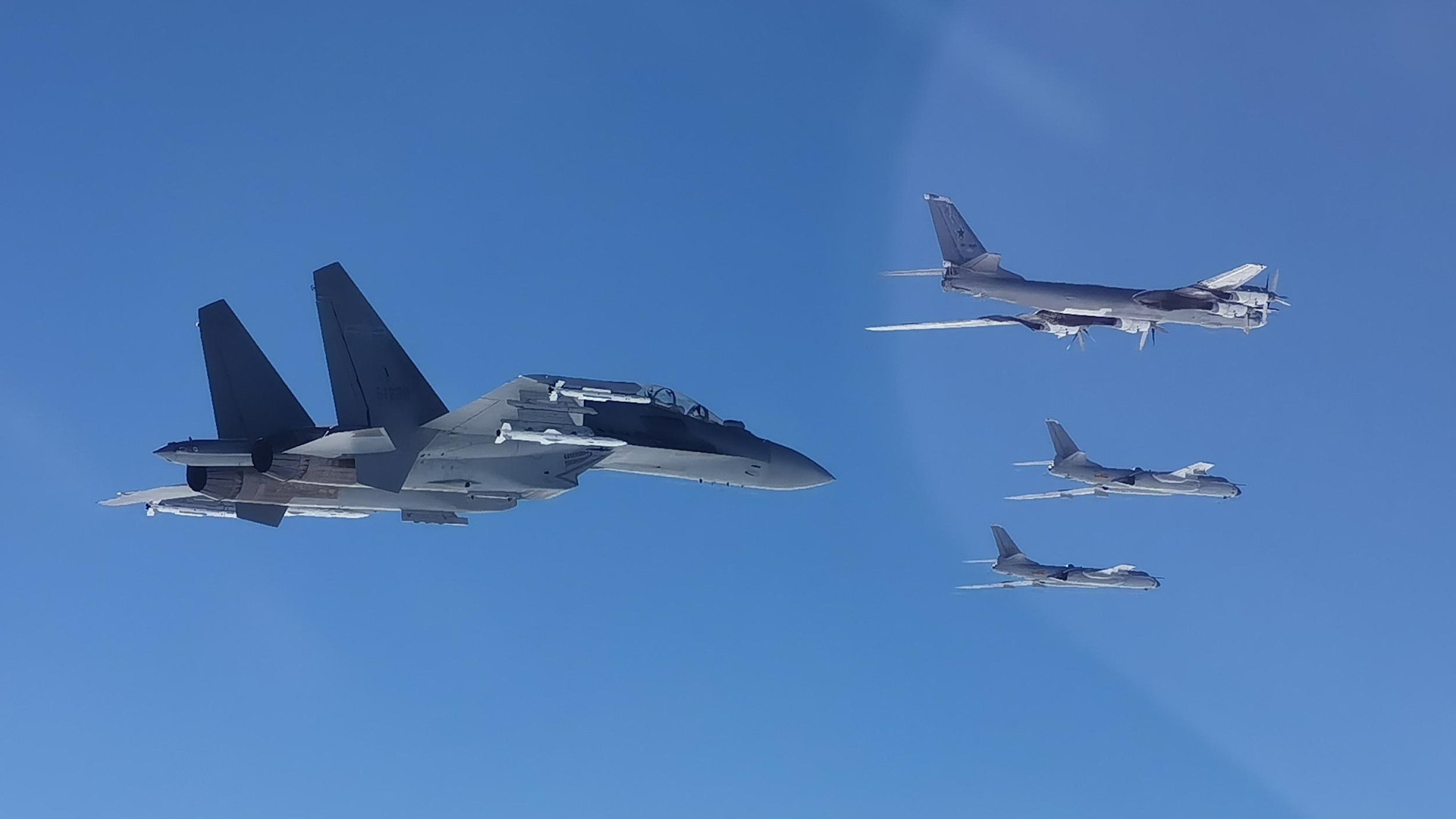
China debuts H-6N nuclear bomber in joint patrol with Russia
By Craig Nigrelli (Anchor), William Jackson (Producer), Jack Henry (Video Editor)
China and Russia conducted a joint patrol of nuclear-capable bombers over the Sea of Japan on Friday, Nov. 29, their ninth such operation since 2019. The patrol featured China’s H-6N bomber, its first deployment in such an exercise, and Russia’s Tu-95MS strategic bomber, according to Chinese state media.
Media Landscape
See how news outlets across the political spectrum are covering this story. Learn moreBias Distribution
Left
Right
Untracked Bias
South Korea’s military reported that 11 Chinese and Russian aircraft entered its air defense identification zone (ADIZ), prompting it to scramble fighter jets. The planes remained in the zone for about four hours but did not breach South Korean airspace. Officials said they lodged formal protests with both Beijing and Moscow over the unannounced flights.
The South Korean military stated that Russian aircraft approached from the northeast over the East Sea, while Chinese planes entered from the south and moved northward. The two groups of bombers met south of Dokdo, a group of islands claimed by both South Korea and Japan, before leaving the ADIZ.
China’s state broadcaster described the patrol as part of an annual plan aimed at strengthening joint training and operational capabilities. Russia has not commented on the exercise.
The joint patrol follows similar missions earlier this year, including a July operation near Alaska that prompted the United States and Canada to dispatch fighter jets. It also comes amid escalating military tensions, including Russia’s recent deployment of a hypersonic missile in Ukraine.
Air defense identification zones, such as South Korea’s ADIZ, require foreign aircraft to identify themselves for security purposes but do not constitute sovereign airspace. These zones often overlap, leading to disputes between nations.
Moscow argued that South Korea’s ADIZ was established unilaterally and does not legally bind other countries. South Korea maintains that all aircraft entering the zone should provide notice and routinely scrambles fighter jets in response to unauthorized entries.
[craig nigrelli]
CHINESE AND RUSSIAN NUCLEAR-CAPABLE BOMBERS CONDUCTED A JOINT PATROL OVER THE SEA OF JAPAN ON FRIDAY. IT MARKS THEIR NINTH OPERATION SINCE 2019. THE MISSION INCLUDED CHINA’S H-6N NUCLEAR-CAPABLE BOMBER—ITS FIRST APPEARANCE IN SUCH AN EXERCISE—AND RUSSIA’S TU-95MS STRATEGIC BOMBER.
SOUTH KOREA’S MILITARY SAYS IT SCRAMBLED FIGHTER JETS AFTER 11 CHINESE AND RUSSIAN AIRCRAFT ENTERED ITS AIR DEFENSE IDENTIFICATION ZONE (ADIZ), STAYING FOR ABOUT FOUR HOURS WITHOUT ENTERING SOUTH KOREAN AIRSPACE.
CHINA’S STATE BROADCASTER CALLED THE PATROL PART OF AN ANNUAL PLAN TO ENHANCE JOINT TRAINING AND OPERATIONAL CAPABILITIES.
SOUTH KOREAN OFFICIALS HAVE PROTESTED THE UNANNOUNCED FLIGHTS, REPORTING THAT RUSSIAN PLANES ENTERED FROM THE NORTHEAST OVER THE EAST SEA, WHILE CHINESE AIRCRAFT CAME FROM THE SOUTH AND MOVED NORTH. THE TWO GROUPS OF AIRCRAFT MET SOUTH OF DOKDO, A GROUP OF ISLANDS IN THE EAST SEA, BEFORE LEAVING SOUTH KOREA’S AIR DEFENSE ZONE WITHOUT INCIDENT.
AIR DEFENSE ZONES REQUIRE AIRCRAFT TO IDENTIFY THEMSELVES BUT DO NOT CONSTITUTE SOVEREIGN AIRSPACE, OFTEN LEADING TO DISPUTES IN OVERLAPPING REGIONS.
MOSCOW ARGUES THAT SOUTH KOREA’S AIR DEFENSE IDENTIFICATION ZONE WAS CREATED UNILATERALLY AND DOESN’T LEGALLY OBLIGATE OTHER NATIONS TO COMPLY. HOWEVER, SOUTH KOREA EXPECTS FOREIGN AIRCRAFT ENTERING THE ZONE TO PROVIDE NOTICE AND ROUTINELY SCRAMBLES FIGHTER JETS, EVEN IF ITS TERRITORIAL AIRSPACE ISN’T BREACHED.
THIS OPERATION FOLLOWS A SIMILAR PATROL IN JULY NEAR ALASKA, WHICH PROMPTED U.S. AND CANADIAN FIGHTER JET RESPONSES.
FOR MORE OF OUR UNBIASED, STRAIGHT FACT REPORTING – DOWNLOAD THE STRAIGHT ARROW NEWS APP TODAY, OR LOG ON TO SAN.COM.
Media Landscape
See how news outlets across the political spectrum are covering this story. Learn moreBias Distribution
Left
Right
Untracked Bias
Straight to your inbox.
By entering your email, you agree to the Terms & Conditions and acknowledge the Privacy Policy.
MOST POPULAR
-
 Getty Images
Getty Images
DHS sees leadership shakeup amid ICE operation leaks
Read4 hrs ago -
 Reuters
Reuters
Pope Francis health update: gradual improvement
ReadYesterday -
 Reuters
Reuters
Protester climbs Big Ben with Palestinian flag causing Westminster Bridge closure
ReadYesterday -
 Reuters
Reuters
House Republicans unveil CR 1 week before govt. shutdown
ReadYesterday




